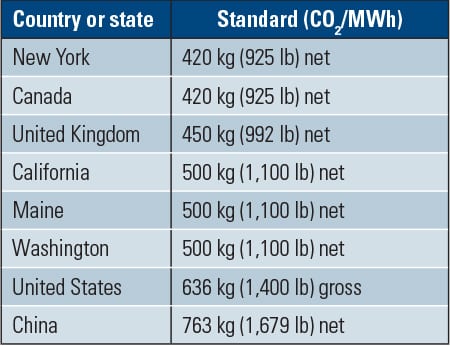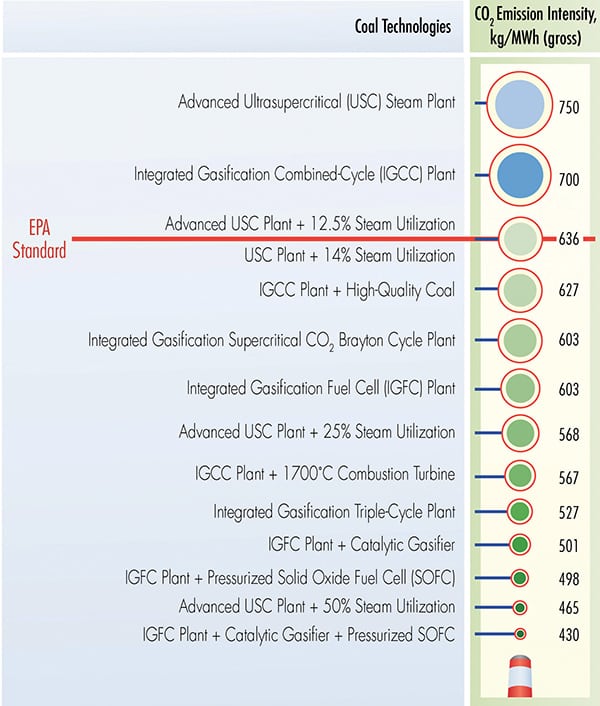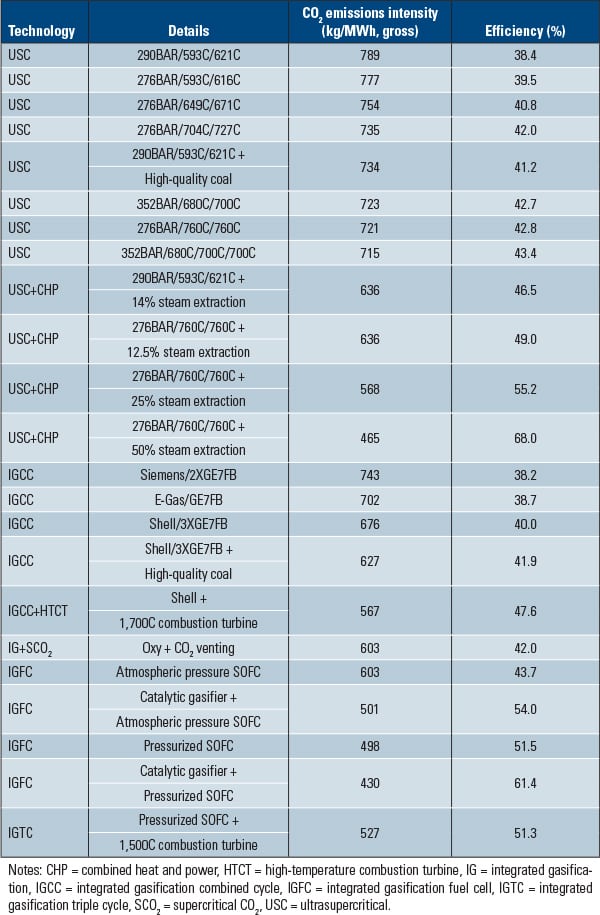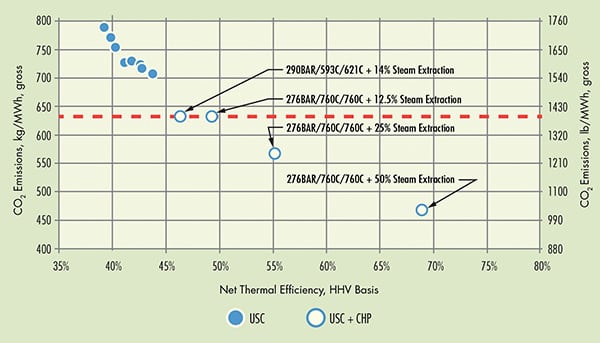CHP and Other Technologies Could Breathe New Life into U.S. Coal-Fired Power Plants
Courtesy: Mississippi Power
An EPRI report finds that carbon capture and sequestration isn’t the only way for new coal power plants to meet recent emissions standards for carbon dioxide. Unlike the other options, combined heat and power (CHP) can meet the requirements and is commercially proven.
Since the U.S. Environmental Protection Agency (EPA) released its “new source performance standard” on August 3, 2015, requiring new coal power plants in the U.S. to emit no more than 636 kg (1,400 lb) of carbon dioxide (CO2) per megawatt-hour (MWh) of gross power produced, the general assumption has been that new coal-fired power plants will only be possible if they include carbon capture and sequestration (CCS). That seems a fair assumption, given that current state-of-the-art coal-fired plants, based on operations at ultrasupercritical (USC) steam conditions above 593C (1,100F), emit approximately 800 kg (1,760 lb) CO2/MWh.
Several U.S. states and a number of countries also have announced or are considering similar restrictions on CO2 emissions from new coal-fired plants (Table 1). Except in China, existing and proposed government standards for CO2 emissions cannot be met solely by building an efficient coal power plant using state-of-the-art USC technology. To achieve the EPA’s limit, the conventional wisdom is that more than 20% of a new U.S. coal plant’s CO2 emissions would have to be captured for long-term sequestration.
 |
|
Table 1. Recent CO2 emissions standards for new coal plants. Source: EPRI |
However, even though CCS has been deemed by the EPA as the “best system of emission reduction,” applications are constrained by technology, policy, and market factors. Power plant developers evaluating possible investments are reluctant to consider new coal generation due to uncertainty, the cost of capture, and the difficulty in finding a suitable storage location.
Current CCS technologies and anticipated near-term commercial offerings for systems to reduce CO2 emissions from fossil-fueled generating plants will not only increase capital costs but also impose significant performance penalties, challenging the competitiveness of new coal generation. Many locations worldwide lack suitable geology for CO2 storage, one of several factors expected to constrain CCS deployment. Even projects with the most ideal set of circumstances, like SaskPower’s Boundary Dam 3 CCS project, have encountered significant unanticipated challenges. (See “SaskPower’s Boundary Dam Carbon Capture Project Wins POWER’s Highest Award” in the August 2015 issue and “SaskPower Admits to Problems at First ‘Full-Scale’ Carbon Capture Project at Boundary Dam Plant” online at powermag.com.)
This poses a question: Is technology available or in development that would enable power plants fueled solely by coal to operate so efficiently that a CO2 emission standard of 636 kg/MWh (1,400 lb/MWh) or less could be met without partial CCS?
Based on high-level assessments described in a recent white paper published by the Electric Power Research Institute (EPRI), the answer is a qualified “yes.” The paper, “Can Future Coal Power Plants Meet CO2 Emission Standards Without Carbon Capture & Storage?” (EPRI report 3002006770) is available at www.epri.com. This article offers highlights of that report, with an emphasis on the only currently commercially available and proven technology route, CHP (Figure 1).
 |
|
1. How coal technologies stack up. Courtesy: EPRI |
In Search of Alternatives to CCS
Some industry executives are beginning to wonder if an easier path to regulatory compliance might be found through advanced coal technology. The answer is clear: Without CCS, meeting or beating the U.S. standard can only be achieved by increasing the thermal efficiency of the energy conversion processes involved in generating electricity from coal—a challenge more easily stated than accomplished (Table 2). EPRI found:
 |
|
Table 2. Technologies considered in EPRI’s analysis, relative to the EPA’s standard. Source: EPRI |
■ Even with steam temperatures exceeding 800C (1,500F)—some 200C (360F) higher than those currently achievable—USC coal plants based on the conventional Rankine steam-electric cycle alone are not capable of meeting the standard.
■ USC plants used in high-efficiency CHP applications are capable of meeting the standard—but only at sites with “thermal hosts” capable of using large volumes of steam.
■ Gasifying coal and then firing the synthesis gas in a conventional combined cycle configuration can meet the standard—but only for certain types of gasifiers, and only when the integrated plant is fueled by high-quality coal.
■ Assuming further technological progress, coal gasification provides multiple pathways for achieving the standard, including gasifiers integrated with solid oxide fuel cells; with combined cycle plants having firing temperatures for the combustion turbine approaching 1,700C (3,100F); or with novel cycle designs.
■ Greater public-private investment in research and development (R&D) is needed to accelerate commercialization of gasification-based cycles and component technologies.
■ Power producers interested in new coal plants could explore potential thermal hosts for CHP projects or the economics of gasifying and firing high-quality coal.
Coal Generation Technologies That Could Meet CO2 Emissions Standards
High-quality bituminous fuel makes up only about half of the world’s coal resource. EPRI’s report focuses on possible technology options for meeting the EPA’s standard while firing subbituminous Powder River Basin coal, representative of widely available lower-rank fuels.
Rankine Cycle Plants with Higher Steam Temperatures. The overwhelming majority of coal-fired power plants are based on the Rankine cycle, in which high-pressure steam is raised from the heat released while burning pulverized coal. Efficiency can be improved by increasing the temperature ratio of the hottest and coldest points in the cycle. For the Rankine cycle, this means increasing the temperature of the steam entering the turbine and/or decreasing the temperature in the condenser at the turbine exit.
Since 2001, an R&D consortium principally funded by the U.S. Department of Energy and the Ohio Coal Development Office has been pursuing advanced materials for coal-fired boilers and steam turbines, with EPRI serving as the technical lead. Nickel alloys in particular show promise of allowing steam temperatures to rise to 760C (1,400F). That would allow an increase in gross thermal efficiency of at least 10%, from the current ~41% for USC plants to ~45% for next-generation advanced USC plants.
This increase in efficiency would not be sufficient to meet the EPA’s standard, but deploying advanced Rankine cycles would significantly decrease the amount of CO2 that would have to be captured and stored. If materials could be developed, that would allow Rankine cycle coal power plants to reach steam temperatures greater than 760C (1,400F). However, EPRI has calculated that a plant capable of meeting the EPA standard of 636 kg/MWh gross (1,400 lb/MWh) would require steam temperatures around 1,125C (2,050F). This is well beyond current materials technology.
Coal Gasification Integrated with Combined Cycles. Gasifying coal to produce a synthesis gas (syngas) opens up additional potential pathways for meeting CO2 emission limits without CCS. The syngas consists predominantly of carbon monoxide (CO) and gaseous hydrogen (H2) fuel. Contaminants, specifically sulfur species and ash mineral content, are removed. Clean syngas is then fired in the open Brayton cycle combustion turbine. The turbine exhaust is fed to the Rankine cycle heat recovery steam generator (HRSG), which also receives steam from the syngas cooler.
State-of-the-art integrated gasification combined cycle (IGCC) units (as is expected for Mississippi Power’s Kemper County IGCC project, shown under construction in May 2015 in the opening image) have thermal efficiencies based on net power output that are similar to those of state-of-the-art, stand-alone Rankine cycle coal power plants, offering significantly lower gross CO2 emission intensities. However, the auxiliary power consumption of IGCCs is greater—an important consideration when gross CO2 emission intensity is the parameter of merit.
IGCC efficiency gains (and resulting reductions in CO2 emissions intensity) can be realized by increasing the firing temperature of the combustion turbine. EPRI’s 2011 IGCC R&D roadmap concluded that going from today’s range of 1,370C–1,430C (2,500F–2,600F) to 1,700C (3,100F) would decrease heat rate by 16%. The technical feasibility of a firing temperature approaching 1,700C (3,100F) has been established; the timeline for commercial deployment of high-temperature combustion turbines optimized for IGCC operation is uncertain but appears to be about a decade away.
Coal Gasification Integrated with Supercritical CO2 Brayton Cycles. Closed Brayton cycles using supercritical CO2 (SCO2) as the working fluid are being investigated by several organizations. (See “Ten Advanced Combustion Systems That Are Getting the Government’s Backing” at powermag.com.) SCO2 is introduced to the burner to dilute the mixture because firing syngas in oxygen would result in temperatures above 2,750C (5,000F), far exceeding the level current turbine technology can tolerate. Recycling a large flow of CO2 moderates the firing temperature to 1,150C (2,100F).
The stream exiting the burner includes a small amount of water vapor but consists mostly of CO2. The ratio of recycled CO2 to that produced by combustion of the syngas is about 10:1. The flow is expanded in a turbine to drive a generator. The turbine exhaust, still at high temperature (>700C or 1,300F), is directed to a large heat exchanger (recuperator), then cooled further to condense out the water vapor. The remaining flow, essentially all CO2, is raised up to high pressure (165 bar or 2,400 psi) and then preheated in the recuperator prior to reintroduction to the burner.
A 2014 EPRI report (3002003734) summarizes findings from an analysis of various syngas-fed oxy-fired SCO2 Brayton plant designs with 100% carbon capture. Various configurations offered increases ranging from >25% to >40% in net thermal efficiency relative to state-of-the-art IGCC plants with 90% CCS, providing CO2 emission intensities below the EPA target.
Coal Gasification Integrated with Solid Oxide Fuel Cells. Fuel cells have long held the promise of higher-efficiency power generation based on natural gas, hydrogen fuel produced via the electrolysis of water, and other gaseous fuels. Combining a coal gasifier with a fuel cell offers a similar opportunity.
In integrated gasification fuel cell (IGFC) power plants, solid oxide fuel cell (SOFC) technology essentially replaces the combustion turbine in IGCC designs. Syngas is fed to the anode side of the cell, and oxygen is supplied by blowing air into the cathode side of the cell. This enables an electrochemical reaction that produces heat and induces direct current, which is converted to grid-compliant alternating current via an inverter.
The chemical reaction in the SOFC does not fully consume the syngas. Any remaining CO and H2 are mixed with hot air leaving the cathode and then are combusted in a burner. The HRSG applies the combustion exhaust from the burner to raise steam, which is mixed with steam produced in the syngas cooler, to drive a steam turbine.
An IGFC plant design operating on CH4-enriched syngas and at elevated pressure would have a CO2 emission intensity of 430 kg/MWh (946 lb/MWh). SOFCs are still at an early stage in the development cycle; according to EPRI’s analysis, megawatt-scale modules are not expected until after 2020.
Coal Gasification Integrated with Triple Cycles. University of Tokyo professor Dr. Shozo Kaneko, among others, has promoted the concept of integrating SOFCs with conventional combined cycle plant configurations to create “triple-cycle” plants that could be fueled by natural gas, coal-derived syngas, or other sources. The potential thermal efficiency advantage of integrated gasification triple cycle (IGTC) over IGFC designs is that hotter turbine inlet temperatures can be achieved by having the SOFC feed a combustion turbine.
EPRI developed a simplified IGTC model and simulated performance based on a conventional coal gasifier, a pressurized SOFC, and a G-class turbine with a 1,500C (2,732F) firing temperature. Results indicate a possible net thermal efficiency of greater than 51% (HHV basis) and CO2 emission intensity of approximately 527 kg/MWh gross (1,159 lb/MWh), sufficient to achieve the EPA standard. Room for improvement in IGTC performance—to achieve even lower limits—appears to exist through design optimization and perhaps eventually through the achievement of a 1,700C (3,100F) turbine firing temperature. SOFC technology remains the limiting factor.
Combined Heat and Power Applications. Another way to increase the thermal efficiency of pulverized coal power plants is to utilize the input fuel’s energy to produce both electric power and useful heat. Combined heat and power or cogeneration (cogen) plants can approach very high utilization rates. The technology is commercially mature. Examples of typical “thermal hosts” for the exported heat from CHP plants are oil refineries, food processing facilities, and central heating (and/or cooling) districts for commercial buildings, large hotels, hospitals, and university campuses.
Because exported heat can displace the burning of fossil fuel that would otherwise have been used to generate heat at the thermal host’s location, the EPA’s standard offers CHP plants full credit for any heat that is exported and put to good use, according to the following formula:
Pgross= [(PeST + PeCT + PeIE – PeFW)/T] + (PtHR + PtIE + PtPS)
Where:
Pgross = Gross energy output of affected facility in MWh.
PeST = Electric energy output plus mechanical energy output (if any) of steam turbine(s) (ST) in MWh.
PeCT = Electric energy output plus mechanical energy output (if any) of combustion turbine(s) (CT) in MWh.
PeIE = Electric energy output plus mechanical energy output (if any) of affected facility’s integrated equipment (IE) that provides electricity or mechanical energy to the affected facility or auxiliary equipment in MWh.
PeFW = Electric energy used to power boiler feedwater (FW) pumps at steam-generating units in MWh.
T = Electric transmission and distribution factor, set to 1.0 for most affected facilities and to 0.95 only for a facility where at least 20% of Pgross consists of electric or direct mechanical output on an annual basis and 20% of Pgross consists of useful thermal energy output on a rolling three-year basis.
PtHR = Hourly useful thermal energy output, measured relative to standard ISO conditions, from heat recovery (HR) for applications other than steam generation or performance enhancement of the affected facility in MWh.
PtIE = Useful thermal energy output relative to ISO conditions from any integrated equipment that provides thermal energy to the affected facility or auxiliary equipment in MWh.
PtPS = Useful thermal energy output of steam, measured relative to ISO conditions, that is used for applications that do not generate additional electricity, produce mechanical energy output, or enhance the performance of the affected facility.
The term PtPS is calculated in MWh as:
Where:
Qm = Measured steam flow in kg (lb) for the operating hour.
H = Enthalpy of the steam at measured temperature and pressure relative to ISO conditions in J/kg (Btu/lb).
3.6 x 109 = Conversion factor in J/MWh (3.413 x 106 Btu/MWh).
Assuming that only steam is exported to a thermal host and that the FW pump is driven by an electric motor, the formula for gross power becomes:
Pgross = PeST – PeFW / T + (Qm x H / 3.6 x109)
To assess the CO2 emission intensity of CHP applications based on the EPA’s formula, EPRI explored four CHP cases, one based on current USC steam conditions and the others starting from an advanced USC plant design with a main steam pressure of 276 bar (4,000 psi) and main and reheat steam temperature of 760C (1,400F). The latter three cases are based on extracting 12.5%, 25%, and 50% of the steam at the cross-over between the intermediate- and low-pressure turbine sections. The results are shown in Figure 2. EPA’s standard of 636 kg/MWh (1,400 lb/MWh), indicated by the dotted red line in the figure, could be achieved by a new CHP plant based on current state-of-the-art USC technology like that employed at the John W. Turk Jr. Power Plant in Arkansas but also incorporating at least 14% steam extraction and utilization. The limit also could be met by using at least 12.5% of the steam from an advanced USC plant. Tighter standards set by U.S. states and other nations could be achieved based on higher CHP fractions.
 |
|
2. CO2 emission intensities of CHP plants based on USC technology with various levels of steam extraction to a thermal host. Courtesy: EPRI |
However, scale is an issue. An advanced USC plant producing nominally 750 MW net with 12.5% steam extraction would require a thermal load of approximately 150 MW—about 50 kg/s (0.4 million lb/h) of steam at 4.7 bar (68 psia) and 367C (693F). As a point of reference, the CHP plant supplying steam to Total’s Gonfreville refinery in Normandy, France, has a thermal load of 330 MW.
Because only a modest number of thermal loads sized at 150 MW or larger are likely to be available, smaller advanced USC plants operating in CHP mode may represent a more widely applicable approach for achieving a CO2 emission intensity of 636 kg/MWh (1,400 lb/MWh) or lower.
More Work Needed
Yes, technology has been identified that would enable new coal power plants to operate so efficiently that the EPA’s CO2 emission standard could be met without partial CCS. However, among all of the options firing subbituminous coal considered in EPRI’s analysis, none with potential to meet the standard are commercially available, economically viable, and suitable for broad deployment. CHP meets the first two criteria, but deployment options are limited.
To help expand the available options, additional public-private R&D investment is needed to accelerate the commercialization of SOFC technologies, higher-temperature turbines capable of operating on coal-derived syngas, and SCO2 Brayton cycles. National R&D programs in the U.S., Japan, and elsewhere are making progress. Greater resources and increased collaboration are recommended due to the challenges that are facing CCS deployment. In addition, a study of existing and potential future thermal hosts capable of accommodating large volumes of steam in the U.S. and other countries is recommended. This would help determine the extent to which the CHP option may be available for building new coal-fired power plants and achieving CO2 emission standards without the need for partial CCS.
— Jeff Phillips is manager of EPRI’s Fossil Fleet for Tomorrow program, which conducts R&D on advanced fossil generation and carbon capture, sequestration, and utilization technologies.
